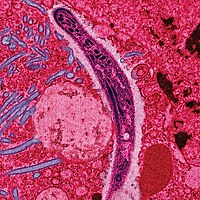
Photo from wikipedia
Background Plague may recur after several decades in its endemic regions; therefore, the continuous monitoring of wildlife is essential, even when no human cases are reported in the old foci.… Click to show full abstract
Background Plague may recur after several decades in its endemic regions; therefore, the continuous monitoring of wildlife is essential, even when no human cases are reported in the old foci. The present study was conducted to monitor rodents and their ectoparasites as well as carnivores to learn about the epidemiology of plague infection in an old focus of Iran. Methodology The present study was conducted from 2019 to 2020 in Takestan county of Qazvin Province in northwestern Iran. Rodents were caught using live traps, and their fleas were separated. Blood and spleen specimens were taken from the captured rodents. Serum samples were also collected from sheepdogs and wild carnivores. The collected samples were tested by culture, serology (ELISA), and molecular methods to detect Yersinia pestis infection. Findings A total of 399 small mammals were caught, of which 68.6% were Meriones persicus. A total of 2438 fleas were collected from the rodents, 95.3% of which were Xenopsylla buxtoni. Overall, 23 out of 377 tested rodents (5.7%, CI 95%, 3.9–9.0) had IgG antibodies against the F1 antigen of Y. pestis, and all the positive samples belonged to M. persicus. Nine (4.8%) out of 186 collected sera from the sheepdogs’ serum and one serum from the Canis aureus had specific IgG antibodies against the F1 antigen of Y. pestis. There were no positive cases of Y. pestis in the rodents and fleas based on the culture and real-time PCR. Conclusion Serological evidence of Y. pestis circulation was observed in rodents and carnivores (sheepdogs and C. aureus). The presence of potential plague vectors and serological evidence of Y. pestis infection in the surveyed animals could probably raise the risk of infection and clinical cases of plague in the studied region. Training health personnel is therefore essential to encourage their detection of possible human cases of the disease.
Journal Title: PLOS Neglected Tropical Diseases
Year Published: 2023
Link to full text (if available)
Share on Social Media: Sign Up to like & get
recommendations!